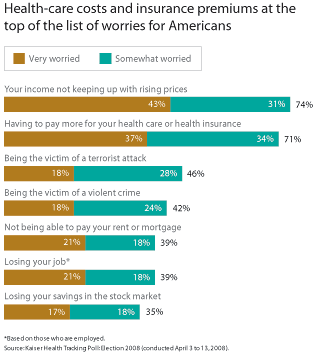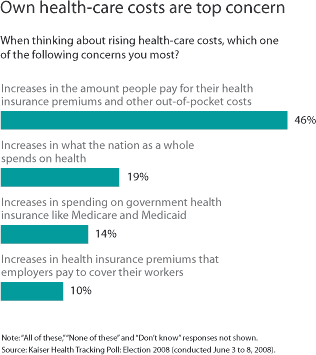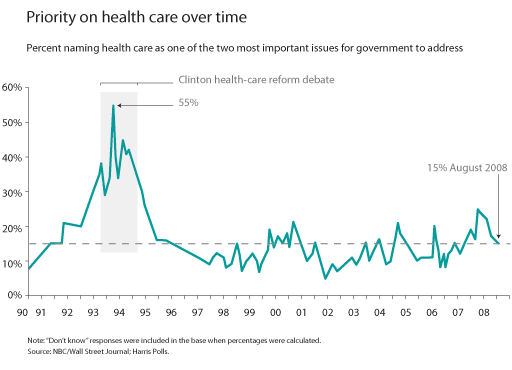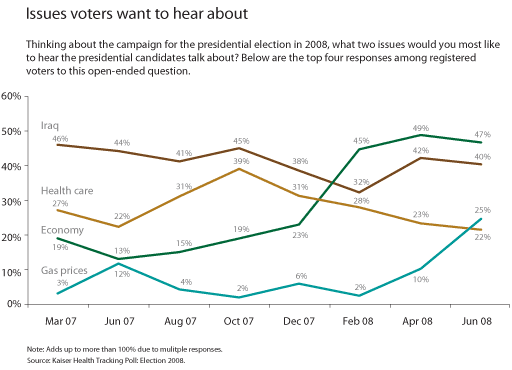FALL 2008 CONTENTS
Home
Prognosis: uncertain
Overhauling the health-care system
SOS NIH
A wake-up call to all who care about science—or for that matter, prosperity
California dreamin’
The Golden State’s golden opportunity
The real issues in health-care reform
Beyond the rhetoric
Bread, butter, and universal health care
Safeway’s CEO talks reform
Armies of the status quo
The Washington health-care lobby
Back to back: Gingrich and Wyden
A Republican and a Democrat weigh in on health-care reform
An open letter to the new president
Science matters
NETworking
Fighting for children’s health inside the hospital and out


The real issues in health-care reform
Beyond the rhetoric
By Drew Altman, PhD
Informational graphics by Arne Hurty
At every talk I give on just about any topic these days, people ask about the prospects for health-care reform legislation in 2009. Where do things really stand?
There is no question that the public is concerned about health care: People are focused on the costs of health care and especially their own health-care bills [Figures 1 and 2]. But health-care reform has to rise on the national policy agenda for this issue to carry the political force needed to compel action. Consider the responses to this survey question comparing the salience of health care at the height of the Clinton health-reform debate in 1993-94 to that of today [Figure 3]. They show health care is a prominent issue, but is far from center stage.
For health care to successfully compete for attention on the national agenda in a shifting-issue landscape [Figure 4], the presidential campaign must mount a debate about health care that engages the national media and the public. Then the new president needs to make health care an early, top priority and exercise leadership in negotiations with Congress on the issue. Leadership can and probably will also come from Congress itself, with several key players likely to make proposals. It is an open question whether the president and Congress will make health-care reform a priority over other issues vying for attention, most notably an ailing economy, Iraq, intensifying problems in Afghanistan and energy. And there’s not much time for this to happen before the mid-term elections, when political compromise on an issue like health-care reform that advantages one side or the other becomes too difficult to achieve.
It’s hard to imagine the American people becoming dramatically more concerned about health care in the next six months than they are today. So what will matter most is what leaders do or don’t do in the short window of opportunity that will open in 2009. At this point, every conceivable outcome is possible: comprehensive legislation, more modest incremental legislation (always the most likely outcome) or no action at all.
If health-care reform gets to the table as an early and top priority for the next Congress, it faces two big obstacles. The first will be finding the money to pay for expanded coverage while Congress is focused on deficit reduction. This will be no easy task. It is one reason, but by no means the only reason, that some policymakers on both the right and the left are looking hard at rescinding the current tax preference for employer-based health insurance, which is worth more than $200 billion per year and could easily pay for most health-care reform proposals as well as other priorities. The second, even bigger, obstacle will be fashioning a reform plan that bridges health care’s ideological and policy divide, which has paralyzed action on health in Washington for many years. This, I have become convinced, is now the biggest hurdle of all — bigger than finding the money to pay for expanding coverage and dueling with health care’s legendary interest groups.
Whether or not there is action in the next Congress, there are fundamental choices that the health-care field and the nation need to debate.
Should the goal of health-care reform be to guarantee universal coverage, or should it be more limited — to make insurance more affordable and available for those who want it and can afford it in the private marketplace?
Should we continue to organize our system around employment-based insurance or move instead to insurance purchased by individuals in the non-group marketplace? If we do that, what needs to be done to make the non-group market work more effectively? Do we regulate it or backstop it with risk pools or other arrangements?
And ultimately: What do we want health insurance to be in our country?
Do we want, and can we afford, more expensive comprehensive coverage (from preventive to catastrophic care) with more modest out-of-pocket costs for people?
Do we want less comprehensive but cheaper insurance with high deductibles, higher out-of-pocket costs for routine care and catastrophic back-end protection? The market is now edging in this direction.
Rhetoric about lofty goals and theoretical arguments over health-care economics often cloud debate. However, at the heart of these conversations lie a few core issues: whether people will get more or less insurance; if they get less, what that will mean for their economic security and their health; and if they get more, what it will mean for our national health-care bill.

Q&A with Drew Altman
Listen to an interview with Dr Altman, president and chief executive officer of the Henry J. Kaiser Family Foundation, a leading independent voice for research and information on U.S. health policy.





